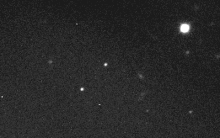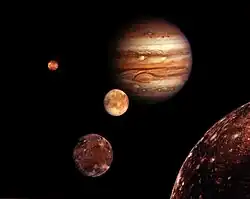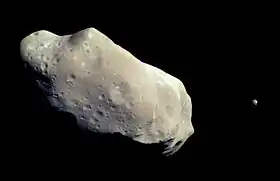Ymir (moon)
Ymir /ˈiːmɪər/, or Saturn XIX, is the second-largest retrograde irregular moon of Saturn. It was discovered by Brett J. Gladman, et al. in 2000, and given the temporary designation S/2000 S 1. It was named in August 2003 after Ymir, who in Norse mythology is the ancestor of all the Jotuns or frost giants.[11]
.jpg.webp) Discovery image of Ymir taken by the La Silla Observatory in August 2000 | |
| Discovery[1] | |
|---|---|
| Discovered by | Brett J. Gladman |
| Discovery site | Observatoire de la Cote d'Azur |
| Discovery date | 2000 |
| Designations | |
Designation | Saturn XIX |
| Pronunciation | /ˈiːmɪər/,[2] /ˈɪmɪər/[3] |
Named after | Ymir |
| S/2000 S 1 | |
| Adjectives | Ymirian /ɪˈmɪəriən/[4][5] |
| Orbital characteristics[6] | |
| 23,040,000 km | |
| Eccentricity | 0.3349 |
| 3.6 yr (1315.14 d) | |
| 244.521° | |
| Inclination | 173.125° |
| 194.086° | |
| 22.668° | |
| Satellite of | Saturn |
| Group | Norse group |
| Physical characteristics | |
Mean diameter | 19+50% −30% km[7] |
| 11.92220±0.00002 h[7] 11 h 55 m 20 s[8] | |
| Albedo | 0.06[9] |
Spectral type | D/P[8] |
| 21.7[10] | |
It takes 3.6 Earth years to complete an orbit around Saturn. Of the moons that take more than 3 Earth years to orbit Saturn, Ymir is the largest, at about 18 kilometres (11 miles) in diameter;[10] Ymir is also the second largest member of the Norse group, after Phoebe.[8]
Spectral measurements from Cassini–Huygens show that Ymir is reddish in color, unlike Phoebe's gray color, suggesting a separate origin for this moon.[8] It shows a similar light curve as Siarnaq and has a triangular shape, rotating in a retrograde direction about once every 11.9 hours.[8]

References
- Brian G. Marsden (2000-10-25). "IAUC 7512". IAU. Retrieved 2011-01-08.
- "Ymir". Merriam-Webster.com Dictionary.
- Merriam-Webster's Encyclopedia of Literature. 1995.
- Budd (1898). "Norse Mythology". St. Mary's Hall lectures: and other papers. p. 84. Because the -r is an inflectional ending, and the oblique stem is Ymi (as in Modern Norse Yme), one might expect the English adjective to be ?Ymian, but that is perhaps too short a word to be easily intelligible.
- James Hall III (2015). Moons of the Solar System. p. 107.
- Jacobson, R.A. (2007) SAT270, SAT271 (2007-06-28). "Planetary Satellite Mean Orbital Parameters". JPL/NASA. Retrieved 2008-02-14.
{{cite web}}: CS1 maint: multiple names: authors list (link) - Denk, T.; Mottola, S. (2019). Cassini Observations of Saturn's Irregular Moons (PDF). 50th Lunar and Planetary Science Conference. Lunar and Planetary Institute.
- T. Denk, S. Mottola, F. Tosi, W.F. Bottke, D.P. Hamilton (2018). Schenk, P.M.; Clark, R.N.; Howett, C.J.A.; Verbiscer, A.J.; Waite, J.H. (eds.). The Irregular Satellites of Saturn (PDF). pp. 409–434. Bibcode:2018eims.book..409D. doi:10.2458/azu_uapress_9780816537075-ch020. ISBN 9780816537075.
{{cite book}}:|journal=ignored (help)CS1 maint: multiple names: authors list (link) - Nicholson, P. D. 2001
- Sheppard, Scott S. "Saturn's Known Satellites". Department of Terrestrial Magnetism. Retrieved 2008-02-14.
- Daniel W. E. Green (2003-08-08). "IAUC 8177: Sats OF (22); Sats OF JUPITER, SATURN, URANUS". IAU. Retrieved 2011-01-08.
External links
- MPEC 2000-Y15: S/2000 S 1, S/2000 S 2, S/2000 S 7, S/2000 S 8, S/2000 S 9 (2000 Dec. 19 ephemeris)
- Ephemeris IAU-NSES
- Saturn's Known Satellites (by Scott S. Sheppard)
- Ymir website (by Tilmann Denk)
.jpg.webp)

